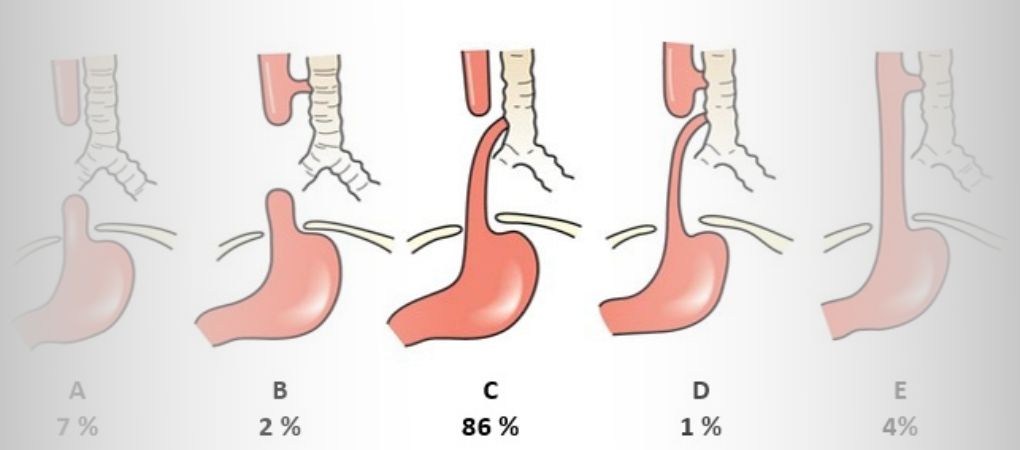Francesca Galiano
|
27/09/2022 - Last update 13/01/2023
Alice Barni, Dario Zecchillo, Stefano Uberti, Silvia Ratti | Year 2019
Osteopathic Manipulative Treatment in a Paediatric Patient with Oesophageal Atresia and Tracheo-Oesophageal Fistula
Pathology:
Esophageal atresia
Type of study:
Case report
Date of publication of the study’:
2019/Apr/09

Purpose of the study
- Objective: to report the effect of OMT on dysphagia symptoms and aspiration risks in an infant with a diagnosis of oesophageal atresia and tracheo-oesophageal fistula
- Measured outcomes: clinical change in the dysphagia symptoms measured with the Paedriatic Eating Assessment Tool-10 (PEDI-EAT-10)
Participants
- Number: 1
- Description: 40-day old infant with a diagnosis of oesophageal atresia with distal tracheo-oesophageal fistula of type C according to the Gross classification. He was born in the 40th week, with a birth weight of 3,3 kg and an Apgar score of 9/10 both at 1st and 5th minute. 6 hours after birth a respiratory distress manifested, to which various examinations followed (X-ray, bronchoscopy, echocardiography and abdominal ultrasonography) which revealed a solitary kidney and a mild tracheomalacia. None of his parents had genetic disorders, and his mother (a 38-year-old woman) had not smoked or consumed alcohol during pregnancy. A thoracoscopic surgery and the ligation of the tracheo-oesophageal fistula were performed during his second day of life. On the 20th day the infant started being fed and on the 30th day after birth he was discharged from hospital with a daily dose of omeprazole (8mg), some feeding advice and an infant-specific formula for reflux. At the visit the mother reported great difficulties in bottle-feeding the baby, including “choking” while eating and vomiting after feeding, despite following the hospital recommendation to hold the infant in an up-right standing position for 30 minutes after eating. The child was particularly irritable with a barking cough and worsening expiratory stridor. He also experienced difficulties falling asleep.The osteopathic evaluation revealed diaphragmatic restrictions, chest and rib stiffness, hypomobility of the tracheal cartilages, hyoid bone in elevation, a somatic dysfunction at cervical level, low cranial rhythmic impulse with an underlying cranial strain dysfunction of compression.
Interventions and evaluations
- Assessment of the dysphagia symptoms and risk of aspiration using PEDI-EAT-10 at the first, fourth and seventh treatment
• PEDI-EAT-10 score equal to or greater than 3 is considered abnormal - 7 fortnightly OMT sessions
- Techniques to improve the movement of the diaphragm, the thorax, the ribs and the cervical regions
• main techniques applied: fascial release, ligamentous/membranous tension balancing, indirect fluid techniques, V-spread and visceral techniques - OMT performed by an osteopath with more than 10 years of pediatric clinical experience
Results
From the beginning of the OMT course of treatment, the PEDI-EAT-10 score went from 7 to 3 and finally down to 1. Out of the various subscales of the PEDI-EAT-10 only a slight difficulty experienced by the child’s parents in increasing the weight of the child has always remained stable due to swallowing problems (and it is the only one remaining stable by the end of the study).
With regard to the osteopathic evaluation, the somatic cervical dysfunction normalized completely and the cranial rhythmic impulse also became normal. No adverse effects were detected due to OMT.
Discussion
The OMT proved to be able to improve the clinical condition of an infant with oesophageal atresia with high aspiration risk, to the point that the PEDI-EAT-10 score decreased to 1, below the abnormality threshold. This effect might depend on the stimuli that the osteopathic techniques give to interstitial and proprioceptive fascial receptors, which can be received by the central nervous system and affect, as a result, both the skeletal muscle tone and the balance of the autonomic nervous system and, therefore, of the smooth muscle. The OMT could also have acted on the fascial and cartilaginous remodeling, thus improving costal, thoracic and cervical mobility.
Therefore, the authors hope for studies focused on other children with esophageal atresia extended to the long term, to see the progress of the clinical conditions once the osteopathic course of treatment is over, an analysis that in this study was missing. In this regard, the child underwent 3 monthly endoscopies following surgery, and his esophagus was dilated with a pneumatic balloon at 3 and 6 months after birth, therefore during and after the end of the OMT sessions.
The review of Osteopedia
By Marco Chiera
Strengths: clinically significant result with the PEDI-EAT-10 score going from abnormal to normal overcoming the threshold score.
Limits: since the OMT sessions took place over a period of 3 months, it would have been useful to describe what else happened to the child, other than the indication of dilation of the esophagus with a pneumatic balloon. In fact, other events might have occurred or the child might have followed other therapies that might have affected the results described here.

Are you an osteopath?
Register and enjoy the membership benefits. Create your public profile and publish your studies. It's free!
Register now
School or training institution?
Register and enjoy the membership benefits. Create your public profile and publish your studies. It's free!
Register now
Do you want to become an osteopath? Are you a student?
Register and enjoy the membership benefits. Create your public profile and publish your studies. It's free!
Register now







